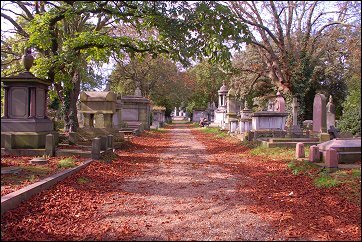
Kensal Green Cemetery
Kensal Green Cemetery’s seventy-seven acres lie just to the west of Golborne Ward, across Ladbroke Grove. Though undeniably somewhat melancholy, the cemetery is a haven of peace and tranquillity, not to mention the home of thirty-one species of lichen.
Many notable characters from the 19th century are buried there including Isambard Kingdom Brunel, William Thackeray and Jean-Francois Gravelet. This latter was better known as The Great Blondin and achieved international fame by crossing Niagara Falls on a tightrope. He did this on stilts, blindfolded, pushing a wheelbarrow, with a man on his back and finally, he cooked and ate an omelette while half-way across.
When it was opened in 1833 in what was still countryside, it was London’s first dedicated cemetery - until then people had been buried in churchyards. But the churchyards were becoming notoriously overcrowded and increasingly noxious, posing a very real threat to public health. The layout and design of Kensal Green was greatly influenced by the Parisian cemetery Père Lachaise.
After it was opened, the cemetery quickly became the fashionable place to be seen dead in when Princess Sophia (1777-1848), George III’s daughter, was buried there. Just to show that Royal scandal is not just a contemporary phenomenon, she was said to have given birth to a child out of wedlock. Competing rumours named the father as either General Thomas Garth, one of the King's equerries, or the Duke of Cumberland, who was Sophia's brother.
Some of the Victorian era’s most colourful individuals are buried at Kensal. Dr James Barry (c.1795-1865) led a successful career as an army surgeon, rose to the heights of Inspector General of the Army Medical Department, and fought a duel with another officer at the Cape of Good Hope. Only after Dr Barry’s death did it emerge that she was a woman.
Andrew Ducrow (1793-1842), a circus owner and bareback rider, was titled the Colossus of Equestrians. While still alive, and at an unprecedented cost of £3,000, (in excess of £200,000 in today’s money), he built his extraordinarily elaborate walk-in tomb which was denounced for its ‘ponderous coxcombry’.
After an unsuccessful career as a painter of biblical scenes, John St. Long John (1798-1834) set himself up on Harley Street as a doctor of medicine, unburdened by training of any sort. Unfortunately, his remedies proved fatal to some of his patients and he was twice forced to defend himself from charges of murder and was once found guilty of manslaughter. He escaped with a fine, and continued to practice.
Nineteenth century novelists Wilkie Collins and Anthony Trollope both lie in Kensal Green. Collins was buried in 1889 amid disorderly scenes when female fans pushed and jostled to grab wreaths and other mementoes.
The cemetery is open to the public in Summer (1st April to 30th September) from 9 AM to 6 PM, Monday to Saturday and 10 AM to 6 PM on Sundays. In Winter, (1st October to 31st March) the hours are 9 AM to 5 PM, Monday to Saturday and 10 AM to 5 PM on Sundays. On Bank Holidays, it is open from 10 AM to 1 PM. Please remember that the cemetery is still in use and that there may be a burial during your visit.
The Friends of Kensal Green offer a two-hour tour of the cemetery every Sunday from March to October, and on the first and third Sundays of each month from November to February. Tours begin at 2 PM from the Anglican Chapel in the centre of the grounds, and finish around two hours later with tea and biscuits at the Dissenters’ Chapel, adjacent to Ladbroke Grove. On the first and third Sunday of each month, this tour also descends to the catacomb beneath the Anglican Chapel (not suitable for children under 12). A suggested donation of £5 per person (concessions £4) helps to support the Friends' work in helping to maintain, study and attract visitors to Kensal Green.
Friends of Kensal Green
General Cemetery Company (which owns and manages Kensal Green).






